牛津英语7A全套教案
- 格式:doc
- 大小:190.50 KB
- 文档页数:44
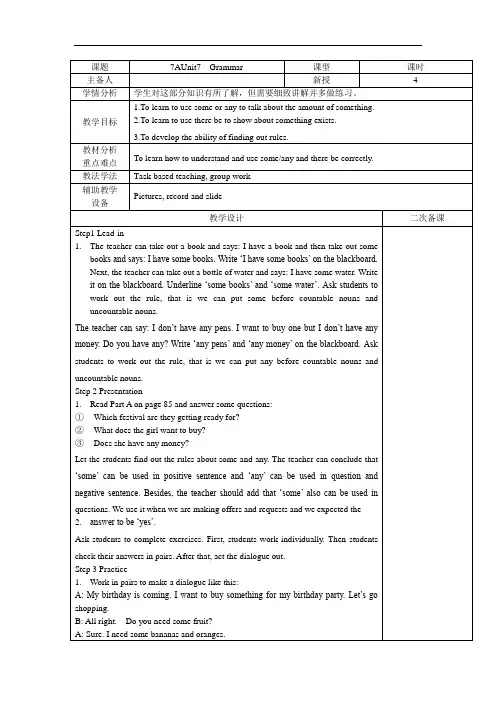
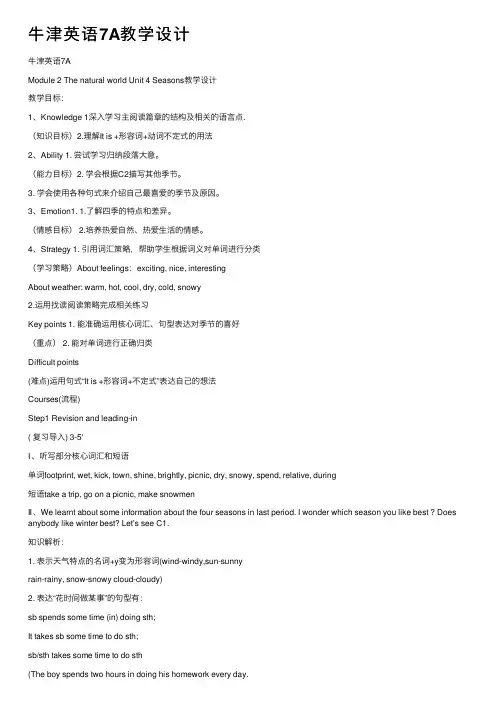
⽜津英语7A教学设计⽜津英语7AModule 2 The natural world Unit 4 Seasons教学设计教学⽬标:1、Knowledge 1深⼊学习主阅读篇章的结构及相关的语⾔点.(知识⽬标)2.理解It is +形容词+动词不定式的⽤法2、Ability 1. 尝试学习归纳段落⼤意。
(能⼒⽬标)2. 学会根据C2描写其他季节。
3. 学会使⽤各种句式来介绍⾃⼰最喜爱的季节及原因。
3、Emotion1. 1.了解四季的特点和差异。
(情感⽬标) 2.培养热爱⾃然、热爱⽣活的情感。
4、Strategy 1. 引⽤词汇策略,帮助学⽣根据词义对单词进⾏分类(学习策略)About feelings:exciting, nice, interestingAbout weather: warm, hot, cool, dry, cold, snowy2.运⽤找读阅读策略完成相关练习Key points 1. 能准确运⽤核⼼词汇、句型表达对季节的喜好(重点) 2. 能对单词进⾏正确归类Difficult points(难点)运⽤句式“It is +形容词+不定式”表达⾃⼰的想法Courses(流程)Step1 Revision and leading-in( 复习导⼊) 3-5'Ⅰ、听写部分核⼼词汇和短语单词footprint, wet, kick, town, shine, brightly, picnic, dry, snowy, spend, relative, during短语take a trip, go on a picnic, make snowmenⅡ、We learnt about some information about the four seasons in last period. I wonder which season you like best ? Does anybody like winter best? Let’s see C1.知识解析:1. 表⽰天⽓特点的名词+y变为形容词(wind-windy,sun-sunnyrain-rainy, snow-snowy cloud-cloudy)2. 表达“花时间做某事”的句型有:sb spends some time (in) doing sth;It takes sb some time to do sth;sb/sth takes some time to do sth(The boy spends two hours in doing his homework every day.It takes the boy two hours to do his homework every day.The boy takes two hours to do his homework every day.)3. 表达“花钱买某物”的句型有:sb spends some money (in/on) buying sthsb spends some money on sthsth costs sb some moneysb pays some money for sth(She spent 20 yuan on this book.She spent 20 yuan in buying this book.The book cost her 20 yuan.She paid 20 yuan for this book.)4. a lot of 意思是“许多”既可以修饰可数名词(=many)⼜可以修饰不可数名词(=much)(a lot of people = many people; a lot of water = much water)5.start意为“开始”,它的同义词是begin,两者都可以接动名词或不定式作宾语,表⽰“开始做某事”1.(start to grow = start growing = begin to grow =2.begin growing)Step2 Autonomic learning, cooperation and communication( ⾃主学习合作交流) 10'Ⅰ、分析重点短语、句型,各⼩组开展造句训练根据汉语提⽰完成句⼦1.很多⼈喜欢夏天去沙滩。
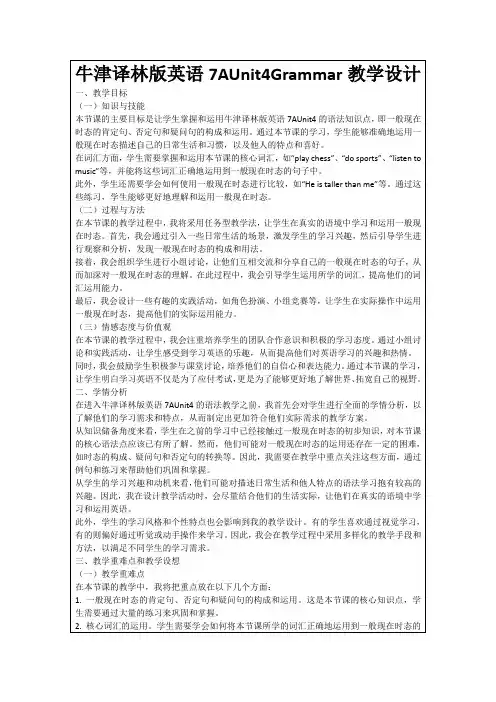
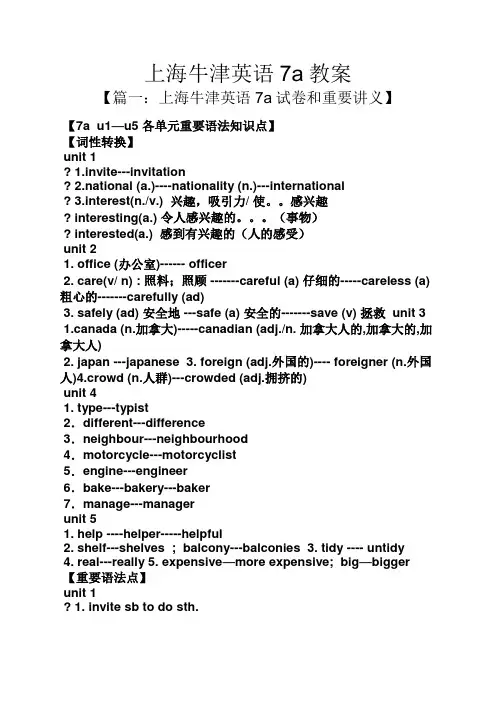
上海牛津英语7a教案【篇一:上海牛津英语7a试卷和重要讲义】【7a u1—u5 各单元重要语法知识点】【词性转换】unit 1? 1.invite---invitation? 2.national (a.)----nationality (n.)---international? 3.interest(n./v.) 兴趣,吸引力/ 使。
感兴趣? interesting(a.) 令人感兴趣的。
(事物)? interested(a.) 感到有兴趣的(人的感受)unit 21. office (办公室)------ officer2. care(v/ n) : 照料;照顾 -------careful (a) 仔细的-----careless (a) 粗心的-------carefully (ad)3. safely (ad) 安全地 ---safe (a) 安全的-------save (v) 拯救 unit 3 1.canada (n.加拿大)-----canadian (adj./n. 加拿大人的,加拿大的,加拿大人)2. japan ---japanese3. foreign (adj.外国的)---- foreigner (n.外国人)4.crowd (n.人群)---crowded (adj.拥挤的)unit 41. type---typist2.different---difference3.neighbour---neighbourhood4.motorcycle---motorcyclist5.engine---engineer6.bake---bakery---baker7.manage---managerunit 51. help ----helper-----helpful2. shelf---shelves ; balcony---balconies3. tidy ---- untidy4. real---really5. expensive—more expensive; big—bigger 【重要语法点】unit 1? 1. invite sb to do sth.? 2. talk to/ with sb. ? 4. talk about sth. (talk to sb about sth) ? 3. on+具体几月几日,on aug.16/ on 16 august 注意读音 ? 4. thank you for+ n.----thank you for your help. thank youfor+ doing---- thank you for writing to me. ? 5. more than = over 超过? 6. the summer palace; the great wall ; the palace museum ? tian’anmen square; yu garden7. see sb doing sth.与 see sb do sth 之间的区别? 8. it takes me 2 hours to finish my homework.?how long does it take you to finish your homework?9. 现在完成时态简单介入:例如: they ha ven’t been to the usa before.i haven’t finished my homework yet.she has already cleaned the classroom.10. another例如:this book is too difficult for me. will you please give me another one?unit 21. have no food or water 在否定句中and应改为“or”2. take sb to somewhere 带某人去某地3. take care of = care for = look after 照顾,照看4. buy sb sth = buy sth for sb 为某人买某物5. save animals from danger 把动物从危险中解救出来6. promise to do 承诺做某事7. 一般过去时态介入8. 名词+ to do,to do 用来补充说明用途例如:give him some water to drink;give him a blanket to keep warm;give it a basket to sleep inunit 31. six million 注意数字表达法:例如:2,700,560 two million seven hundred thousand five hundred and sixty2. 注意国家名称和国籍的区别。
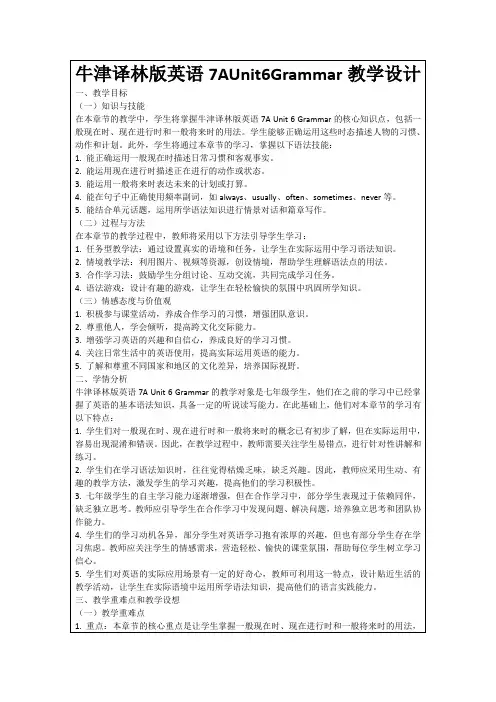
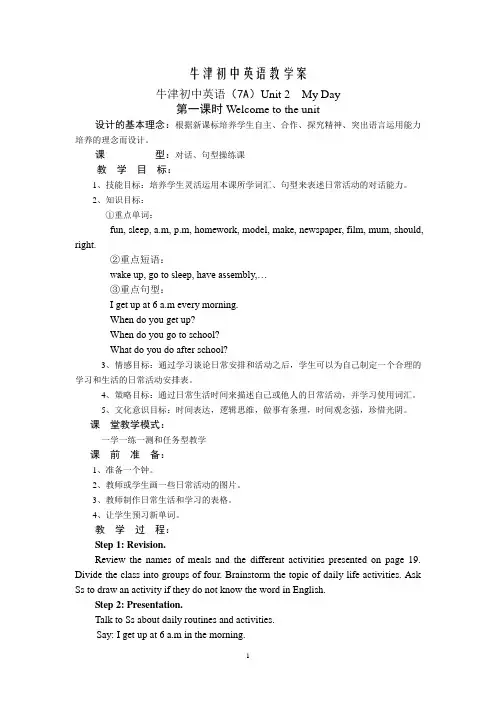
牛津初中英语教学案牛津初中英语(7A)Unit 2 My Day第一课时Welcome to the unit设计的基本理念:根据新课标培养学生自主、合作、探究精神、突出语言运用能力培养的理念而设计。
课型:对话、句型操练课教学目标:1、技能目标:培养学生灵活运用本课所学词汇、句型来表述日常活动的对话能力。
2、知识目标:①重点单词:fun, sleep, a.m, p.m, homework, model, make, newspaper, film, mum, should, right.②重点短语:wake up, go to sleep, have assembly,…③重点句型:I get up at 6 a.m every morning.When do you get up?When do you go to school?What do you do after school?3、情感目标:通过学习谈论日常安排和活动之后,学生可以为自己制定一个合理的学习和生活的日常活动安排表。
4、策略目标:通过日常生活时间来描述自己或他人的日常活动,并学习使用词汇。
5、文化意识目标:时间表达,逻辑思维,做事有条理,时间观念强,珍惜光阴。
课堂教学模式:一学一练一测和任务型教学课前准备:1、准备一个钟。
2、教师或学生画一些日常活动的图片。
3、教师制作日常生活和学习的表格。
4、让学生预习新单词。
教学过程:Step 1: Revision.Review the names of meals and the different activities presented on page 19. Divide the class into groups of four. Brainstorm the topic of daily life activities. Ask Ss to draw an activity if they do not know the word in English.Step 2: Presentation.Talk to Ss about daily routines and activities.Say: I get up at 6 a.m in the morning.When do you get up? etcStep 3: Ask Ss to sort their activities into different sections:Leisure — Sports — Eating — school.Teacher tells Ss to write down the day and time when they typically do these activities. As you go around the class, provide help with vocabulary.Step 4: Each group writes the four lists on the board. Ss can copy the activities they want to include in their diary.Step 5: Work in pairs to talk about their partner‟s diary. You can use the following sentence patterns:a. When do you go to scho ol /…/ ?b. Do you go to school by bus /…/ ?c. What do you do after school /…/ ?Step 6: Learn Vocabulary.a. P23 Go through Part A and read the words and phrases correctly. Attention to their pronunciation.b. Ss complete the task and check answers. Encourage Ss to memorize the collocations Part B.c. Let Ss go through Part B and explain the context. Ask Ss to do the task on their own, then check answers. Ss correct any mistakes and the teacher explains something if necessary.d. Divide the class into pairs. Let Ss read the conversation and get some pairs to act it out.Step 7: Practice — task.课堂教学任务。
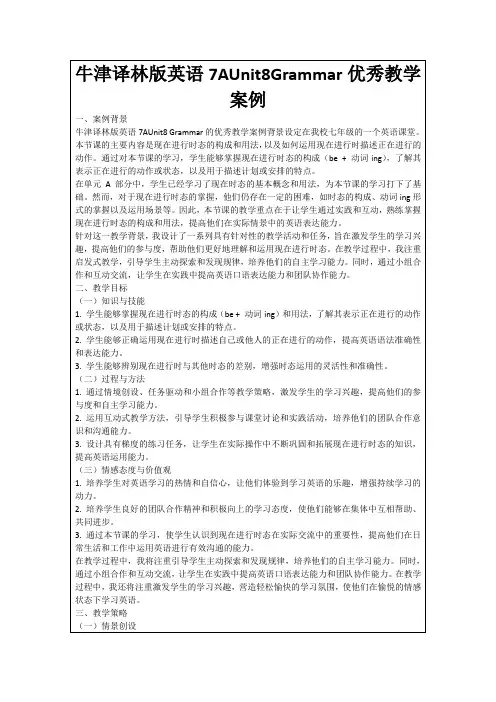
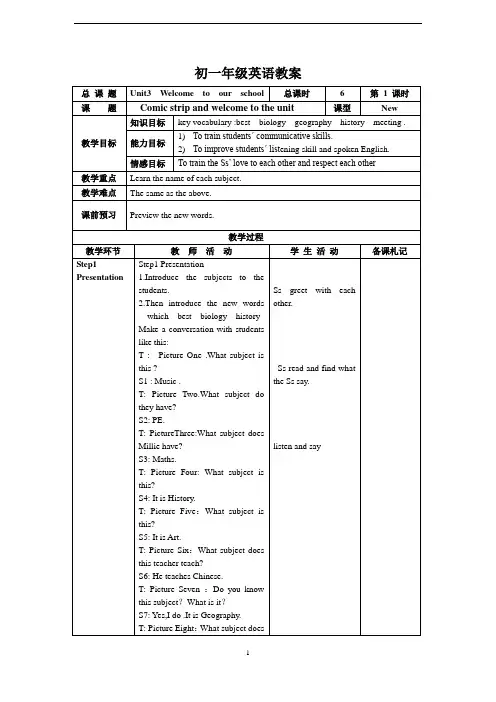
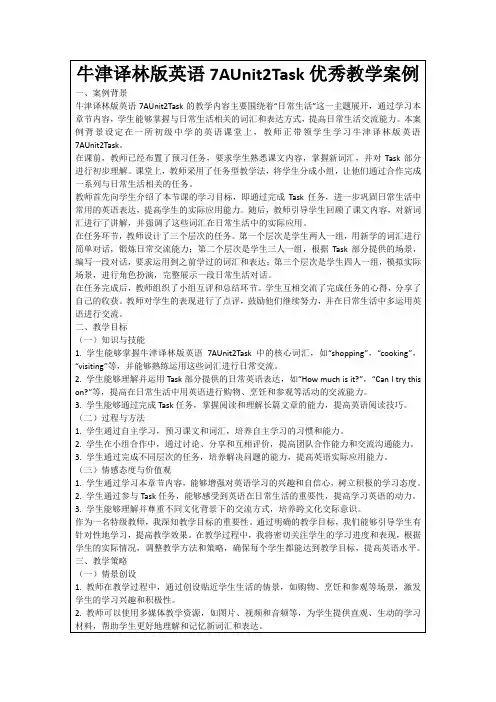
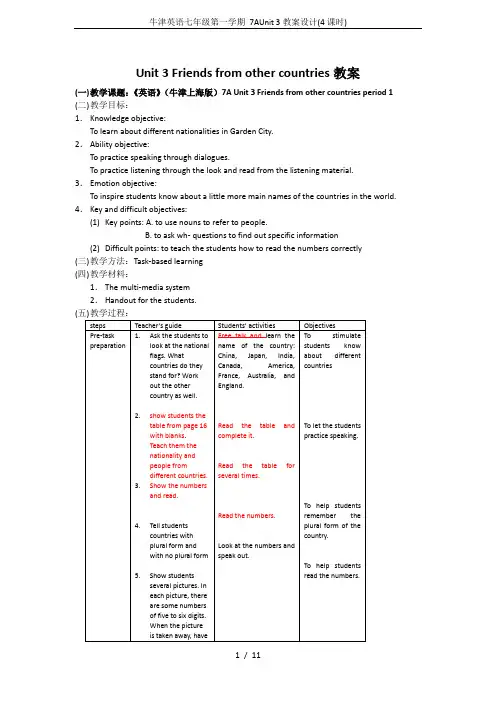
Unit 3 Friends from other countries教案(一)教学课题:《英语》(牛津上海版)7A Unit 3 Friends from other countries period 1(二)教学目标:1.Knowledge objective:To learn about different nationalities in Garden City.2.Ability objective:To practice speaking through dialogues.To practice listening through the look and read from the listening material. 3.Emotion objective:To inspire students know about a little more main names of the countries in the world. 4.Key and difficult objectives:(1)Key points: A. to use nouns to refer to people.B. to ask wh- questions to find out specific information(2)Difficult points: to teach the students how to read the numbers correctly(三)教学方法:Task-based learning(四)教学材料:1.The multi-media system2.Handout for the students.(Feedback 1I.Translation(写出下面词组)1.花园城市的外国人________________2.一个拥挤的城市__________________3.超过八百万人____________________4.举个例子________________________5.叫来自英语的人英国人____________II.Choose the best answer(选择正确的答案)1.---Have you bought any present for your friends from Japan?---Yes, I _______.A.doB. didC. haveD. had2.I’d like ______ some sweets.A.havingB. to haveC. haveD. had3.Let’s go for a trip _______ a sunny day.A.onB. inC. forD. at4.Where do Tim and Tom ______ from?esB. comeC. isD. are5.There is going to _______ a class meeting this afternoon.A.haveB. hasC. beD. isIII.Rewrite the sentences as required. (按要求改写句子)1.Mum has already bought much fruit. (改为否定句)Mum ________ _________ much fruit ________.2.He needs 100 yuan to buy the food. (改一般疑问句)_______ he ________ 100 yuan to buy the food?3.Tom’s new friend comes from the USA. (划线部分提问)_______ ________ Tom’s new friend come from?4.Sandy does exercise every morning. (划线部分提问)_______ _________ Sandy _______ every morning?5.There are five million people in Garden City. (划线部分提问)_______ ________ people are there in Garden City?后记:将表格放在前面教授,为文章做铺垫。
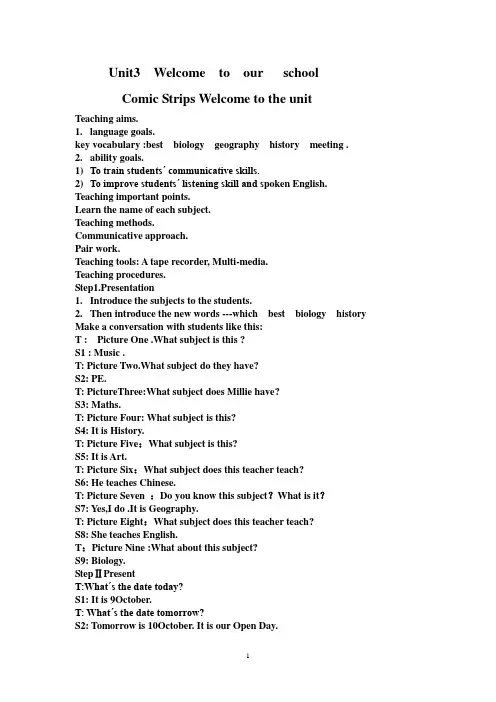
Unit3 Welcome to our schoolComic Strips Welcome to the unitTeaching aims.nguage goals.key vocabulary :best biology geography history meeting . 2.ability goals.1)To train studentsˊ communicative skills.2)To improve studentsˊ listening skill and s poken English. Teaching important points.Learn the name of each subject.Teaching methods.Communicative approach.Pair work.Teaching tools: A tape recorder, Multi-media.Teaching procedures.Step1.Presentation1.Introduce the subjects to the students.2.Then introduce the new words ---which best biology history Make a conversation with students like this:T : Picture One .What subject is this ?S1 : Music .T: Picture Two.What subject do they have?S2: PE.T: PictureThree:What subject does Millie have?S3: Maths.T: Picture Four: What subject is this?S4: It is History.T: Picture Five:What subject is this?S5: It is Art.T: Picture Six:What subject does this teacher teach?S6: He teaches Chinese.T: Picture Seven :Do you know this subject?What is it?S7: Yes,I do .It is Geography.T: Picture Eight:What subject does this teacher teach?S8: She teaches English.T:Picture Nine :What about this subject?S9: Biology.StepⅡPresentT:Whatˊs the date today?S1: It is 9October.T: Whatˊs the date tomorrow?S2: Tomorrow is 10October. It is our Open Day.T: It is for parents to visit school.StepⅢPractise.1, Please listen to the tape and answer the questions.1) Whatˊs the date of the Open Day in Millieˊs school?2) Can Millieˊs mother go to her school?3) What time does the parentsˊmeeting begin?4) What else do parents do after the meeting ?5) Where does Millie meet her mother?2:Divide the students into two groups and read the conversation twice.StepⅣHomework.1: Remember the four skills vocabulary and expressions in the period.2: Finish off related exercises after school.教学后记ReadingTeaching aims:nguage goals.Key vocabulary: show front modern diary bright hall.Key phrase : in a white shirt in front of first floor have meetingsshow sb around in the libraryTarget language :What is the building over there? Whoˊthat man in a white shirt?2.Ability goals.1)To train study skill of scanning .2)To understand main information of the text.Task –based teaching Skimming and scanningTeaching toolsA tape recorder . Multi –media .Four picture.Teaching procedures.StepⅠRevisionReview the languages about subjects.Step ⅡListening .1.Please listen to the tape and answer some questions.1)How does Millieˊs school look?2)How many classrooms are there?3)Whoˊs that man in a white shirt?2.Students answer the questions.StepⅢ PresentationShow four pictures of different places at Millieˊs school.Help her write thecorrect words under the picture.StepⅣPractice.Read the information about Sunshine Middle School.Write a T if a sentence is true or an F it is false.1. Sunshine Middle School looks beautiful. -----------2. Millie and her mum are behind the classroom building. ------------3. Millieˊs classroom is on the ground f loor. --------------4. They have a new library. -------------5. They have meetings in the library. -------------6. They do not have a school hall. --------------7. Mr Wu is in a white shirt on the Open Day. --------------8. Mr Wu is Millieˊs Chinese teacher. -------------- StepⅤPractice.1.Play the tape for students to listen and repeat,pay attention to thepronunciation and intonation,then complete Millieˊs diary.2.Ask some students to retell the text.StepⅥ Homework1.Review new words.2.Introduce our school.3.Recite the conversation on Page 32 after class.教学后记GrammarTeaching aims.nguage goals.Key vocabulary wall pardon .phone let me see on the phoneTarget language .1)Simon loves football. He is in the football team.2)Do you know the teacher over there,Simon and Sandy?2.Ability goals.1)To grasp the usage of the Subject and Object forms of personal pronouns. 2)To use the personal pronouns to replace nouns.3)Using the Simple Present Tense to talk about oneˊs activ ities.Teaching important points.To make positive and negative statements with proper personal pronouns. Teaching methods.Situation and Communicative approach.Teaching tools.Multi- media A tape recorder.Teaching procedures.Step ⅠRevisionReview key vocabulary learned last period and check for understanding of nouns and verbs.Step ⅡPresentation1.Lead in the new grammar items using situation approach.Make sure Sscan understand well.2.List the personal pronouns on the blackboard and encourage Ss explorethe usage of the two forms.3.Get Ss to read out the sentences in PartA and understand the meaning ofeach one.Then ask Ss to draw a line from the pronoun to the noun it refers to.Step ⅢPractice1.Ask Ss to complete their conversation with the correct personal pronouns .2.Discuss answers and ask them why they choose a particular personalpronoun .Make sure that the whole class knows the correct answers.3.Ask Ss to practice the conversation in PartB and then select a few pairs to doa class presentation.4.Ask Ss to look at the sentences and ask them to complete the sentences ontheir own.Then check the answers with the whole class.5.Ss read the article for general understanding only.Give a quick explanation ofany words they do not know.Ask Ss to complete the task alone.Then read the article to the class.Try to deal with all the problems after reading in order to maintain the students’ interest.StepⅣDiscussionList some useful vocabulary on the Bb and make Ss to probe into the usage of them.Play with both/ all be good atStepⅤExtensive activity1.Get Ss to give their reasons why the personal pronouns are used.2.Ask students to underline all the personal pronouns in Reading partonPage36.3.Look at Multi-media to do some consolidating work.Analyze together.Step ⅥWorkbook1.Review new words.2. Introduce personal pronouns(object form)3.Recite the conversation on Page 35 after class.教学后记Integrated skillsnguage goals.Key vocabulary : take from---to--- get up go to school reading room all kinds of borrow---from--- only a.m. p.m.2.Target language.1)----How do you get to school?-----By bike./Take the bus.2) It takes me about half an hour.3)It takes her about twenty minutes to get to school.4)It is open from 8a.m.to 5:30 p.m.3. Ability goals.1) To train students’ listening skills.2) To improve students’ speaking and writing skills.Teaching difficult points.To learn how to listening to the text.Teaching ,speaking and writing.Teaching tools.A tape recorder and six pictures.Step ⅠpresentationTake about My school freely.T; 1. Do you like your school?2.It is big or small?3.What do you have in you school?4.Do you have a building ?5.How many floors does the building have?6.Which floor is your classroom on?7.Do you have a library?8.It is open every day?9.What can you do in the library?10.Are there many books in you library?Students answer the questions.Step ⅡPractice1.T:Amy’s cousin ,Shirley,wants to know more about Amy’s school.Please listen to their conversation and answer this question:What place are they talking about?2.Ask the students to listen to the tape,then answer the questions.3.Ask the students to listen to the tape again .Write a T if a sentence is true or an F if it is false.1). The library in Amy’s schoo l is big . _____2). It is open from 9 a.m. to 5p.m. _____3). The reading room is only open in the afternoon. _____4). There are many books in the library. ______5). Amy often borrows CDsfrom the library.______Step ⅢPractice1.Ask the students to listen to the tape again and read after the recorder.2.T: Students on the right play the role of Amy.Students on the left play therole of Shirley.Then we change the roles ,OK?Ask the students to read the text.Step ⅣHomework.1.Remember the words ,phrases and sentences they learned.2.Recite the textB3.Finish the workbook.教学后记Study skillsnguage goals.Key vocabulary: pen bed tea day cup get home man night drink late read year week.2.Target language.1). We can sing the English song .2). Look left,then right,then left when you crossthe road.3). Bring me a birthday cake on you way back.4). Lucy likes the number ninety-nine.5). Peter puts his pencils and pens on the book.3.Ability goals.1) To train students’ listening .Pay attention to the sounds of the consonants.2) To improve students’ listening skills.Teaching methods.Listening and speaking.Teaching tools.A tape recorder and six pictures.Step1. Presentation.Teacher takes out six pictures.There are some sentences on it.Pay attention to the sounds of the consonants.1). Picture One.Peter wears a ________(cap).He has an ________(apple)and a ______(pie).He is very _________(happy).2). Picture Two. A____(baby)is in the ____(bed).It wants the _______(bananas) on the ____(table).3). Picture Three.What is the _____(time)?Please _____(tell)me.I want to go ____(boating)with my _____(sister).4). Picture Four. It is _____(windy)today.____(Would) you please close the____(door)and the ______(window).5). Picture Five.Kate has a _____(car)and a ____(cat).They are both _____(black).She likes this _______(colour)very much.6).Picture Six. A_____( girl )and a _____(dog)go to the green ____(grass).They will begin a game there.Step2.Practice1.Ask the students to read the word on P39. Pay attention to the sounds of the consonants.2.Read the words in part A. Pay attention to the different sounds of the letters in bold.3.Ask the students to fill in different letters to make up two words for each group.1)__ook ___ook 2)___atch __atch 3)foo__ foo___4) ___alk ___alk 5)___ind ___indStep3 PractiseAsk the students to practice saying the sentences in PartC. Pay attention to the sounds of the letters in bold.Step4.Homework1.Read the words on page39.2.Do the exercises on the workbook.3.Recite the sounds of the consonants.教学后记Tasknguage goals.Key vocabulary: a few away far away from on foot best all the best. Target language :1)Our playground is infront of the classroom.2)I go to school on foot every day.3)It takes me about an hour to get to school.2.Ability goals.1)To train students’ reading skills.2)To get students to understand how to write a letter.Teaching methods.Readingand practicing.Teaching tools.A tape recorder and a project.Teaching procedures.Step1. Presentation.T: Excuse me ,how do you get to school every day?S1: I get to school by bus.T: Oh,you take a bus to school.I think it is a long way from your home to school,right?S1:Yes.T: Excuse me ,how do you get to school every day?S2.I walk to school.T: I see. You live near our school.So you go to school on foot.I know a lot of students come to school by bus.And only a few students come on foot.Now we learn on foot.Step2.Practice.1.T: Millie has a penfriend ,Liu Yi.He is at Hope Middle School.He often writes to Millie.Please read the letter and answer the question.What does Liu Yi write about in this letter?Ss answer:He writes about his school,the playground ,the teacher and how he goes to school every day.2.T: Please answer the following questions in pairs to know more details aboutLiu Yi ‘s school.1)What is the name of his school?2)Is his school bigor small?3)How many classrooms do they have?4)Do they have a playground?5)Do they have a reading room?6)How does he go to school?7)How long does it take him to go to school?3.Ask the students to read the article in PartA after the tape.Step3 Action.Teacher writes some sentences on the Bb,then ask the Ss to answer the questions.1). Which school do you study at?2). What do you have in you school?3). Is your playground big or small?4) .Are there any trees at your school?5). Where do you live ?6). How do you go to school every day?7).How long does it take you take you to go to school?Step4.Writing.1.T: What do you think of your own school?Do you love yourschool?Now ,you have the change to write about your school.Please answer the questions in PartB with your own information.2.Now,do you best to write an article about your school.You can use someuseful expressions on page 40.Step5.Homework.1. Remember the words ,phrases and sentences they learned.4.Recite the textB5.Finish the workbook. 教学后记:。
上海牛津英语7a教案【篇一:上海牛津英语7a试卷和重要讲义】【7a u1—u5 各单元重要语法知识点】【词性转换】unit 1? 1.invite---invitation? 2.national (a.)----nationality (n.)---international? 3.interest(n./v.) 兴趣,吸引力/ 使。
感兴趣? interesting(a.) 令人感兴趣的。
(事物)? interested(a.) 感到有兴趣的(人的感受)unit 21. office (办公室)------ officer2. care(v/ n) : 照料;照顾 -------careful (a) 仔细的-----careless (a) 粗心的-------carefully (ad)3. safely (ad) 安全地 ---safe (a) 安全的-------save (v) 拯救 unit 3 1.canada (n.加拿大)-----canadian (adj./n. 加拿大人的,加拿大的,加拿大人)2. japan ---japanese3. foreign (adj.外国的)---- foreigner (n.外国人)4.crowd (n.人群)---crowded (adj.拥挤的)unit 41. type---typist2.different---difference3.neighbour---neighbourhood4.motorcycle---motorcyclist5.engine---engineer6.bake---bakery---baker7.manage---managerunit 51. help ----helper-----helpful2. shelf---shelves ; balcony---balconies3. tidy ---- untidy4. real---really5. expensive—more expensive; big—bigger 【重要语法点】unit 1? 1. invite sb to do sth.? 2. talk to/ with sb. ? 4. talk about sth. (talk to sb about sth) ? 3. on+具体几月几日,on aug.16/ on 16 august 注意读音 ? 4. thank you for+ n.----thank you for your help. thank youfor+ doing---- thank you for writing to me. ? 5. more than = over 超过? 6. the summer palace; the great wall ; the palace museum ? tian’anmen square; yu garden7. see sb doing sth.与 see sb do sth 之间的区别? 8. it takes me 2 hours to finish my homework.?how long does it take you to finish your homework?9. 现在完成时态简单介入:例如: they ha ven’t been to the usa before.i haven’t finished my homework yet.she has already cleaned the classroom.10. another例如:this book is too difficult for me. will you please give me another one?unit 21. have no food or water 在否定句中and应改为“or”2. take sb to somewhere 带某人去某地3. take care of = care for = look after 照顾,照看4. buy sb sth = buy sth for sb 为某人买某物5. save animals from danger 把动物从危险中解救出来6. promise to do 承诺做某事7. 一般过去时态介入8. 名词+ to do,to do 用来补充说明用途例如:give him some water to drink;give him a blanket to keep warm;give it a basket to sleep inunit 31. six million 注意数字表达法:例如:2,700,560 two million seven hundred thousand five hundred and sixty2. 注意国家名称和国籍的区别。
Starter Unit 1 Getting to know you 逐渐认识你一Greetings问候Look and sayHello, I’m Ben.你好,我是本。
Hi, I’m Mark.你好,我是马克。
Nice to meet you.见到你很高兴。
Nice to meet you, too.我也是。
This is Kitty. She is my sister.这是基蒂。
她是我的妹妹。
Hi, Mark.你好,马克。
Hi, Kitty.你好,基蒂。
Goodbye, Mark.再见,马克。
Bye, Kitty. Bye Ben.再见基蒂。
再见,本。
★重点词汇Hello 喂 nice 令人愉快的 meet 遇见 goodbye 再见 this 这 thank 谢谢★语法聚焦1.一般现在时的用法;2.系动词am, is的用法;3.副词too的用法。
Read and Act 读一读,演一演。
Alice: Good morning, Kitty. 艾丽斯:早上好,基蒂。
Kitty: Good morning, Alice. 基蒂:早上好,艾丽斯。
This is Mark .He’s my friend.这是马克。
他是我的朋友。
Alice: How are you,Mark? 艾丽斯:你好吗,马克?Mark: Fine, thank you .And you?马克:很好,谢谢。
你好吗?Kitty: I’m fine, too. 基蒂:我也很好。
重点难点解析1. Hello, rm Ben,你好,我是本。
▲hello是英语中使用频率最高的日常用语之一,可用来表示问候、打招呼或引起对方注意,可以用于熟人、朋友之间,也可以用于陌生人之间,可以单独使用,也可加称呼语。
在两人见面问候时,意为‚你好‛,在打电话时,意为‚喂‛。
hi在现代英语中以代替hello,显得更加随和。
【注”熟人之间,在说了声‚Hi,‛‚Hello‛之后,还会关心地补上一句:‚How are you?‛(你身体好吗?)对方马上回答说:‚Fine/Not bad/Very well, thank youhhanks! And you?‛(很好/不坏/非常好,谢谢。
初一年级英语教案总课题Unit1 This is me!总课时6第1课时课题Comic strip and welcome to the unit课型New 知识目标To grasp the words : e-dog, master, look after, good night教学目标能力目标To learn how to greet with each other in English.情感目标To train the Ss’ tl o veeach other and respect each other教学重点To learn how to greet with each other.教学难点The same as the above.课前预习Preview the new words.教学过程教学环节教师活动学生活动Step1Free talk Ss greet with each Revision Ask the Ss to greet their partners.other.1)Show Ss a clock and say:Ss read and find whatAt this time of day, how do you greet the Ss say.Step2your teacher or your partner?listen and say Presentation2)Today we are going to meet somefriends at Beijing SunshineStep3.Presen Secondary School. This is their firsttation English class. Open your books atPage 7 and read aloud what the Sssay.Show Ss a picture & say: Look!Ihave two new friends. Point to Eddie,say: It ’as dog. Then Hobo: It ’anse-dog. Ask: Do you want to know hisname?Say: I have an e-dog. I look after mye-dog every day.Who is his master?教学环节教学过程学生活动备课札记通过这样一个情境的设置,可以激发学生的学习动机,更好地参与到课堂中来。
苏教版牛津英语初中七年级上册精品教案全册第一部分简要提示(ppt2)一、年级:七年级二、教学内容: 7A Unit 1This is me!三、课型: Checkout四、教学目标1.知识目标:学生掌握本单元教授的语法和语言知识(四会)。
(ppt3)2.能力目标:为学生提供在不同语境中使用新学语法和词汇的机会。
3.情感目标:学生在完成练习的过程中对自己的学习有个客观的评价,以获得成就感,并树立学好英语的自信心。
五、教学重难点1.重点:掌握和运用本单元的词汇,句型和语法。
2.难点:学会在语境中正确运用一般现在时,并注意第三人称单数的用法。
第二部分教学流程Part One Language pointsStep 1.T: Hello, boys and girls! Today let’s learn the last period in Unit 1—Checkout . We will learn to use grammar and vocabulary in our life . 同学们好!今天我们要学习本单元的最后一课—复习检查课。
我们将学会在实际生活中来运用语法和词汇。
(ppt4)First, we’ll learn something about these students. Please do it one by one.首先,我们来了解一些同学的情况.请同学们一个接一个地回答。
(ppt5)T: 1) They are all 12 years old now, so they are of an a_________.2) Simon’s favourite basketball p________ is Yao M ing.3) Amy’s hair isn’t long , it’s s__________.4) We have Chinese, English, M_______ and PE on Monday.5 )Simon often plays football on the football f__________ after school.(ppt6)6) Millie e_______ reading books after class.7) My friend Kitty likes listening to m______.8) We love to f_______ kites in the park in spring.9) Simon always b_________ my ruler when he does his homework.10) Sandy is good at swimming. She is tall and s_________.Answers: age, player, short, Maths, field, enjoys, music, fly, borrows, slim.Step 2. (ppt7)T: Well done! Let’s play games together. We are going to do from level one tolevel four. Come on!大家说得很好! 下面我们一起做游戏。
牛津英语7A全套教案________________________________________Starter Unit 1 Getting to know you 逐渐认识你一Greetings问候★重点词汇Hello 喂nice 令人愉快的meet 遇见goodbye 再见this 这thank 谢谢★语法聚焦1.一般现在时的用法;2.系动词am, is的用法;3.副词too的用法。
课文英汉对照Look and sayHello, I\'m Ben.你好,我是本。
Hi, I\'m Mark.你好,我是马克。
Nice to meet you.见到你很高兴。
Nice to meet you, too.我也是。
This is Kitty. She is my sister.这是基蒂。
她是我的妹妹。
Hi, Mark.你好,马克。
Hi, Kitty.你好,基蒂。
Goodbye, Mark.再见,马克。
Bye, Kitty. Bye Ben.再见基蒂。
再见,本。
Read and Act 读一读,演一演。
Alice: Good morning, Kitty. 艾丽斯:早上好,基蒂。
Kitty: Good morning, Alice. 基蒂:早上好,艾丽斯。
This is Mark .He\'s my friend. 这是马克。
他是我的朋友。
Alice: How are you,Mark? 艾丽斯:你好吗,马克?Mark: Fine, thank you .And you? 马克:很好,谢谢。
你好吗?Kitty: I\'m fine, too. 基蒂:我也很好。
重点难点解析1. Hello, rm Ben,你好,我是本。
▲hello是英语中使用频率最高的日常用语之一,可用来表示问候、打招呼或引起对方注意,可以用于熟人、朋友之间,也可以用于陌生人之间,可以单独使用,也可加称呼语。
在两人见面问候时,意为“你好”,在打电话时,意为“喂”。
hi在现代英语中以代替hello,显得更加随和。
【注〕熟人之间,在说了声“Hi,”“Hello”之后,还会关心地补上一句:“How are you?”(你身体好吗?)对方马上回答说:“Fine/Not bad/Very well, thank youhhanks! And you?”(很好/不坏/非常好,谢谢。
你呢?),以示给对方的回敬。
而陌生人之间,在说了声:“Hello”之后,再补上一句“How do you do?”对方跟着重复一句:“How do you do?”2. Nice to meet you.见到你很高兴。
▲双方初次见面经介绍后常说的一句话,这是陌生人初次见面的客套话。
这句话也可用于双方好久未见,偶然相逢时的场合,表示一种高兴的心情。
回答时一般说Nice to meet you, too. too意为“也”,放在句末。
3. This is Kitty.这是基蒂。
▲在第三者给双方作介绍时,通常用This is+姓名这一句型。
在这种场合通常不说He is...或She is...。
如:Ii Lei: Mum, this is my teacher, Miss Wang. 李雷:妈妈,这是我的老师,王老师。
MisLi: Nice to meet you, Miss Wang. 李夫人:见到你很高兴,王老师。
Miss Wang: Nice to meet you, too, Mrs.Li 王老师:见到你也很高兴,李夫人。
二Meeting each other互相见面★重点词汇Friend 朋友how 如何teacher 老师Mr 先生Miss小姐Excuse 原谅★语法聚焦1.陈述句的否定:be + not;2.一般疑问句的回答Yes/No;3.句型Are you...? 课文英汉对照Look and sayMum, this is Kitty and this is Ben. 妈妈,这是基蒂,这是本They are my friends. 他们是我的朋友。
Hello, Mrs Wang. 你好,王夫人。
Hi,Ben .Hi, Kitty. 你好,本,你好,基蒂。
Good afternoon, Miss Li.下午好,李老师。
This is my mum. 这是我的妈妈。
Mum, this is my teacher, Miss Li.妈妈,这是我的老师,李老师。
How do you do? 您好!How do you dc? 您好!Read and actAlice: Excuse me, sir. 艾丽斯:打扰了先生。
Are you Mr Smith? 您是史密斯先生吗?Mr Brown:No, I\'m not. 布朗先生:不,我不是。
I\'m Jack Brown.我是杰克•布朗。
Alice: Sorry, Mr Brown. 艾丽斯:对不起.布朗先生三Meeting my classmates见我的同学们★重点词汇name 名字;How old 多大;What 什么;everyone 大家,每个人;one , two , three hundred 一、二、三••一百★语法聚焦问姓名What is your name?的用法;问年龄How old are you?的用法。
课文英汉对照Look and say 看一看,说一说Hello, I\'m Miss Li.What are your names? 你们好,我是李老师。
你们叫什么名字?Hello, my name is Alice.Hi, everyone. I\'m Eddie. 你们好,我叫艾丽斯。
大家好。
我是埃迪。
How old are you,Alice?I\'m 11.艾丽斯你多大?我11岁。
What about you,Eddie? Are you 11,too?No, I\'m 12. 埃迪你呢?你也11岁吗?不,我12岁。
Ask and answer 问一问,答一答S1:What\'s your name? S2:My name is…/I\'m... Sl:你叫什么名字?S2:我叫……/我是……S1:How old are you? S2: I\'m... Sl:你多大?S2:我……重点难点解析1. What are your names?你们叫什么名字?▲初次见面一般可以询问对方的姓名,英语中常用What\'s your二?对方可回答My nameis…或I\'m ...2. How old are you, Alice?艾丽斯你多大了?▲询问对方年龄用“How old + be+人称代词?’’这一句型。
how是疑问副词,how old意为“多大年龄”,“几岁”。
由how开头的疑问句属于特殊疑问句,用降调读。
其回答用主语+be十数字+(years old),如:-How old,you?-I\'m ten years old.-你多大?-我十岁。
注意:在西方,一般不当面问对方的年龄,因为这是个人隐私,打探别人的隐私是很不礼貌的。
3. Are you 11, too?你也十一岁吗?▲too是副词,意思是“也”,只用于肯定句,多用于句末,也可用于句中,但不可用于句首。
①My mother is coming, too.我母亲也要来了。
We, too,are going away.我们也要走了。
4. What about you, Eddie?埃迪,你呢?▲What about…?表示“……怎么样?”或“……好吗?”,常用在征求同意、提出请求或询问看法的问句中。
如:1)What about your bag? 你的包怎么办呢?2 )What about seeing a film this evening?今天晚上去看电影怎么样?四Meeting my family见我的家人★重点词汇this is这是grandfather 爷爷father父亲brother 哥哥;弟弟Are you…?你是……吗?mother母亲sister姐姐;妹妹grandmother奶奶★语法聚焦1.一般现在时的用法;2.介绍某人This is... ;3. Nice to meet you.的用法及回答。
课文英汉对照Look and saySimon, this is my mother. 西蒙,这是我的妈妈。
Mum, this is my friend, Simon. 妈妈,这是我的朋友西蒙。
Hello, Simon. Nice to meet you. 你好,西蒙。
很高兴见到你。
Nice to meet you too, Mrs U.我也很高兴见到您,李夫人。
Simon, this is my father. 西蒙,这是我的父亲。
Hello, Mr Li 您好,李先生。
Hello, Simon.你好,西蒙。
Look and learnmother brother sister母亲哥哥/弟弟姐姐/妹妹Say and actIntroduce your family,like this:像这样介绍你的家人:Sl:This is my grandfather/grandmother/father/ mother/brother/sister. (a family member),this is my friend, (S3\'s name).S1:这是我的爷爷l奶奶/父亲l母亲l兄弟/姐妹。
(一个家庭成员),这是我的朋友,(学生3的名字)。
S2: Hello, (S3\'s name).Nice to meet you. S2:你好,(学生3的名字)。
很高兴见到你。
S3:Nice to meet you too. S3:我也是。
重点难点解析1. Simon, this is my mother.西蒙,这是我的母亲。
▲my表示“我的”,是形容词性物主代词,这类词有以下几种:第一人称单数my我的;第二人称单数your你的;第三人称单数his他的her她的its 它的第一人称复数our我们的第二人称复数your你们的第三人称复数their他们的▲在词组或句子中,形容词性物主代词不能单独使用,后面必须加名词才能构成一个完整的意思。
例如:This is my father.如果句中没有father,那么这个句子的意思就表达不清了。
2. mum与mother的区别▲mother是正式场合向别人介绍母亲时或书面语所用的,相当于汉语的“母亲”,mum主要用于口语中,称呼自己的母亲时所用,相当于汉语的“妈妈”。